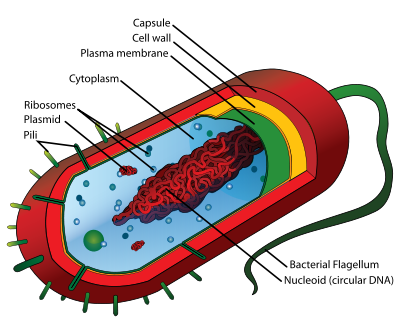|
Defined only by the actions of the candidate...
We previously in a single page examined how inanimate objects behave. In this and several following pages will try to explore how animate (living) matter behaves. Beginning with a definition of life and a look at it in its simplest form seems like a good place to start.
There seems to be pretty good agreement among biologists that life is defined by certain activities that an object carries out. Below is one example of such a list of activities.
•Maintaining its boundaries.
•Movement.
•Responding to stimuli.
•Ingestion.
•Metabolism.
•Excretion.
•Reproduction
•Growth
•Exhibiting homeostasis
•Evolving
There is a decent Wikipedia article on cells that can help explain these basic building blocks of living things. Be prepared to learn some new words when reading this article. Included in the above Wikipedia article is a drawing of a bacterial prokaryote cell. We will use that as an example of a simple one-cell lifeform.

•Capsule - Found in some bacterial cells, this additional outer covering protects the cell when it is engulfed by other organisms, assists in retaining moisture, and helps the cell adhere to surfaces and nutrients.
•Cell Wall - Outer covering of most cells that protects the bacterial cell and gives it shape.
•Cytoplasm - A gel-like substance composed mainly of water that also contains enzymes, salts, cell components, and various organic molecules.
•Cell Membrane or Plasma Membrane - Surrounds the cell's cytoplasm and regulates the flow of substances in and out of the cell.
•Pili - Hair-like structures on the surface of the cell that attach to other bacterial cells. Shorter pili called fimbriae help bacteria attach to surfaces.
•Flagella - Long, whip-like protrusion that aids in cellular locomotion.
•Ribosomes - Cell structures responsible for protein production.
•Plasmids - Gene carrying, circular DNA structures that are not involved in reproduction.
•Nucleiod Region - Area of the cytoplasm that contains the single bacterial DNA molecule.
These single cell lifeforms have barely sufficient structure to carry out all the activities that define life. It is suggested that all plant and animal life evolved from prokaryote cells. That may well be the case but there remain some serious gaps in the story of how exactly it came about. In any event, that is not the question that brought us here. What I wonder is how these things came to exist during the first 109 years or so of Earth's existence. A few possibilities come to mind. Perhaps the prokaryote formed by the chance encounter of all the necessary ingredients. Perhaps the first of these complex single cell creatures evolved from something simpler. Perhaps the universe is arranged in a way, not obvious to us now, that favors the rise of lifeforms from inanimate matter - in spite of the evident tendency of things to proceed naturally from order to disorder. Perhaps the application of intelligence accomplishes what chance alone could not reasonably be expected to do.
I will pursue all these perhapses in following pages.
|




